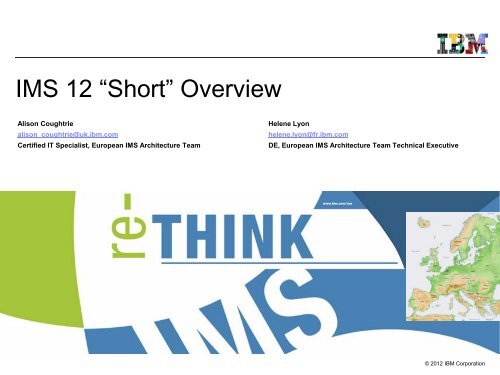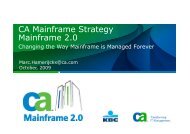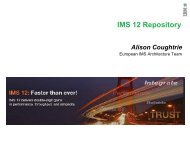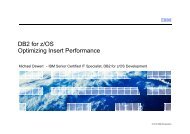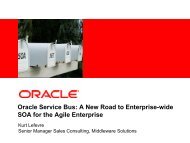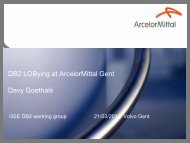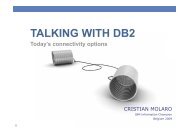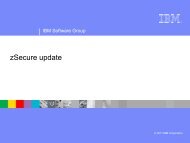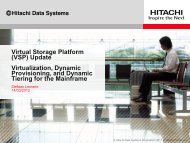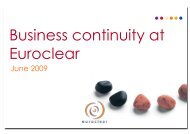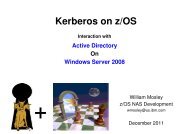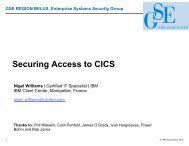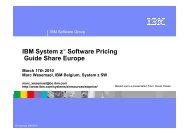IMS 12 - GSE Belux
IMS 12 - GSE Belux
IMS 12 - GSE Belux
Create successful ePaper yourself
Turn your PDF publications into a flip-book with our unique Google optimized e-Paper software.
<strong>IMS</strong> <strong>12</strong> “Short” Overview<br />
Alison Coughtrie<br />
alison_coughtrie@uk.ibm.com<br />
Certified IT Specialist, European <strong>IMS</strong> Architecture Team<br />
Helene Lyon<br />
helene.lyon@fr.ibm.com<br />
DE, European <strong>IMS</strong> Architecture Team Technical Executive<br />
© 20<strong>12</strong> IBM Corporation
<strong>IMS</strong> <strong>12</strong> is Generally Available!<br />
• <strong>IMS</strong> Version <strong>12</strong> “Generally Available” on 28th October 2011<br />
1<br />
© 20<strong>12</strong> IBM Corporation
<strong>IMS</strong> Version <strong>12</strong> Performance Evaluation Summary<br />
• Whitepaper “<strong>IMS</strong> Version <strong>12</strong> Performance Evaluation Summary”<br />
– Detailed results of SVL internal performance tests<br />
– Environment, functions tested, MIPS and<br />
throughput results<br />
Available for download from<br />
ibm.com/software/data/ims/<br />
2<br />
© 20<strong>12</strong> IBM Corporation
<strong>IMS</strong> Roadmap<br />
• <strong>IMS</strong> <strong>12</strong> supports migration/coexistence from/with <strong>IMS</strong> 10 and <strong>IMS</strong> 11.<br />
• Current <strong>IMS</strong> Releases<br />
– <strong>IMS</strong> 10 Generally Available in October 2007<br />
– <strong>IMS</strong> 11 Generally Available in October 2009<br />
– <strong>IMS</strong> <strong>12</strong> Generally Available in October 2011<br />
• <strong>IMS</strong> <strong>12</strong>+1 Planning and Design<br />
• <strong>IMS</strong> <strong>12</strong>+2 Planning<br />
• Gentle Reminders<br />
– <strong>IMS</strong> 9 GA October 2004, Service was discontinued on 7th November 2010<br />
– <strong>IMS</strong> 10 was withdrawn from marketing on <strong>12</strong>th September 2011 (Announcement Letter,<br />
ZP11-0254)<br />
– <strong>IMS</strong> 10 will be withdrawn from service on <strong>12</strong>th November 20<strong>12</strong> (Announcement<br />
Letter, ZP11-0341)<br />
3<br />
© 20<strong>12</strong> IBM Corporation
Discontinuance of Support<br />
• <strong>IMS</strong> Version 11 is the last version of <strong>IMS</strong> that supports the Knowledge Based Log<br />
Analysis (KBLA) facility<br />
• <strong>IMS</strong> Version <strong>12</strong> is the last version to support the SECURITY macro<br />
– Initialization parameters can be used to specify most of the SECURITY macro keyword<br />
values<br />
– Initialization parameters for the RCLASS and SECCNT keywords will be delivered<br />
through the <strong>IMS</strong> Service process (PM48204/UK74051)<br />
• It’s recommended that the startup parameters be used<br />
4<br />
© 20<strong>12</strong> IBM Corporation
<strong>IMS</strong> <strong>12</strong> Main Highlights<br />
Database Management<br />
Transaction Management<br />
System<br />
• <strong>IMS</strong> Catalog<br />
• Dynamic Full Function<br />
Database Buffer Pools<br />
• CICS Open Thread TCB<br />
Support (Threadsafe)<br />
• FF DB Storage Enhancement<br />
• Usability and Serviceability<br />
Enhancements<br />
• <strong>IMS</strong> to <strong>IMS</strong> TCP/IP<br />
Communications<br />
• MSC TCP/IP Support<br />
• OTMA TCP/IP Support<br />
• <strong>IMS</strong> Connect Enhancements<br />
• CM0 Message Enhancement<br />
• Send Only w/ACK for Callout<br />
• OTMA Security<br />
Enhancements<br />
• APPC/OTMA Sync SQ<br />
• <strong>IMS</strong> Repository for Dynamic<br />
Resource Definition<br />
• IMPORT Command<br />
Enhancements<br />
• Logger Enhancements<br />
• Extended Address Volume<br />
Support for non-VSAM<br />
• Member OLC Enhancement<br />
Fast Path<br />
• DEDB Secondary Indexing<br />
Enablement<br />
• 64-bit Buffer Manager<br />
Enhancements<br />
• Usability and Serviceability<br />
Enhancements<br />
DBRC<br />
• Usability and Serviceability<br />
Enhancements<br />
• Migration/Coexistence<br />
5<br />
© 20<strong>12</strong> IBM Corporation
Smarter<br />
Database<br />
Management<br />
6<br />
© 20<strong>12</strong> IBM Corporation
<strong>IMS</strong> Enterprise Suite Explorer for Development<br />
• New Face of <strong>IMS</strong> …Simplifying <strong>IMS</strong> application development<br />
– GUI-based framework for consistent and integrated tools across environment<br />
– Eclipse-based<br />
– Follow-on product for DLIModel Utility<br />
• Easier visualization and editing of <strong>IMS</strong> Database and Program Definitions<br />
– Graphical display of <strong>IMS</strong> segment hierarchy and database structure<br />
– Graphical editors to display/create <strong>IMS</strong> PSBs<br />
– Graphical editors to edit/add fields to DBDs<br />
– Generation of DBD and PSB source<br />
• Ability to easily access <strong>IMS</strong> data using SQL statements using Open database<br />
• Connectivity to the z/OS system<br />
– Browse datasets and submit JCL<br />
– Import and export DBD and PSB source files from a data set to the <strong>IMS</strong> Explorer, and<br />
vice-versa<br />
Download the <strong>IMS</strong> Explorer<br />
ibm.com/ims<br />
Click on <strong>IMS</strong> Enterprise<br />
Suite<br />
7<br />
© 20<strong>12</strong> IBM Corporation
<strong>IMS</strong> Explorer for Development<br />
Graphically-driven editors to<br />
display and update <strong>IMS</strong> program<br />
and database definitions<br />
Graphical interface to<br />
easily access and<br />
manipulate <strong>IMS</strong> data using<br />
standard SQL<br />
Generate SQL<br />
to access <strong>IMS</strong><br />
data<br />
See database<br />
relationships<br />
Change DBD and<br />
PSB definitions<br />
8<br />
© 20<strong>12</strong> IBM Corporation
<strong>IMS</strong> Catalog - Background<br />
• Customers needs not being met<br />
– No trusted online source for both <strong>IMS</strong> database and application metadata information<br />
• Customers can’t leverage newer <strong>IMS</strong> database functions<br />
– Large scale deployment of <strong>IMS</strong> Open Database is difficult<br />
– JDBC metadata discovery APIs are insufficient<br />
• Can’t visualize and report on databases, generate SQL queries, query database contents,<br />
generate pureQuery applications, etc.<br />
• Customers limited to database metadata generated by <strong>IMS</strong> Explorer and/or DLIModel<br />
Utility<br />
– Current Java metadata classes are …<br />
• not trusted and inflexible<br />
• offline and not guaranteed to be current<br />
• lacking application information<br />
• not easy to manage for large scale Open Database solutions<br />
• hard to maintain and keep in sync with <strong>IMS</strong> resources<br />
• deployed everywhere<br />
9<br />
© 20<strong>12</strong> IBM Corporation
What is Metadata?<br />
• Business metadata<br />
– Business rules, definitions, terminology, glossaries, algorithms and lineage using<br />
business language<br />
– Audience: Business users<br />
• Technical metadata<br />
– Defines source and target systems<br />
• Table & Column / Segment & Field structures and attributes<br />
• Derivations and dependencies<br />
– Audience: Specific tool users, AD, BI, ETL, profiling, modeling<br />
• Operational metadata<br />
– Information about application runtime<br />
• Frequency, record counts, component by component analysis and other statistics<br />
– Audience: Operations, management and business users<br />
Literally, “data about data” that describes your company’s<br />
information from both a business and a technical perspective<br />
10<br />
© 20<strong>12</strong> IBM Corporation
<strong>IMS</strong> Catalog - Solution<br />
• A Key component of the <strong>IMS</strong> growth strategy<br />
– Simplification<br />
– Integration<br />
• Provide a trusted, online source for <strong>IMS</strong><br />
database and application metadata<br />
information<br />
• Uses an <strong>IMS</strong> Database to store the <strong>IMS</strong><br />
metadata information<br />
• Allows for better scalability of Open Database<br />
by removing the local metadata requirement<br />
• Benefits<br />
– Offers a trusted and comprehensive view of<br />
<strong>IMS</strong> database metadata managed by <strong>IMS</strong><br />
using standard interfaces<br />
•JDBC/SQL and DLI<br />
– Opens up metadata discovery and exchange<br />
for <strong>IMS</strong> Open Database and the <strong>IMS</strong><br />
Explorer for application developers<br />
– Permits future <strong>IMS</strong> integration with IBM tools<br />
•COGNOS<br />
•Optim Development Studio<br />
•Rational Asset Analyzer<br />
•InfoSphere Data Architect<br />
– Enables scalable and flexible <strong>IMS</strong> Open<br />
Database solutions<br />
•Applications no longer need to maintain local<br />
Java metadata<br />
•Applications can reference the online <strong>IMS</strong><br />
Catalog<br />
11<br />
© 20<strong>12</strong> IBM Corporation
Before the <strong>IMS</strong> Catalog<br />
• Databases partially defined in the <strong>IMS</strong> DBD<br />
– Only searchable fields needed by applications<br />
– Remaining segment data is not defined<br />
• Remaining database definition is within Applications<br />
– COBOL COPYBOOKs and PL/I INCLUDEs map all the segment data<br />
– Applications can have different mappings for one segment<br />
<strong>IMS</strong><br />
User maintained<br />
COBOL/PLI<br />
PSBLIB<br />
ACBLIB<br />
DBDLIB<br />
source<br />
PSB source<br />
DBD source<br />
DLIModel<br />
Utility or <strong>IMS</strong><br />
Explorer<br />
generated<br />
Java classes<br />
<strong>IMS</strong> Database Metadata<br />
<strong>12</strong><br />
© 20<strong>12</strong> IBM Corporation
With the <strong>IMS</strong> Catalog<br />
• Database and program resources defined to an <strong>IMS</strong> system and relevant application<br />
information stored as metadata in an <strong>IMS</strong> catalog<br />
– Databases, fields, segments, data types, and more …<br />
• Changes are reflected in the <strong>IMS</strong> catalog when you create, alter or delete <strong>IMS</strong><br />
resource or application information<br />
• Updates to the <strong>IMS</strong> Catalog are done only via integrated <strong>IMS</strong> processes<br />
– Catalog Populate Utility (initial Catalog load and member update)<br />
– PSBGEN - DBDGEN - ACBGEN<br />
• Catalog metadata can be used to<br />
– Enhance understanding<br />
– Improve consistency<br />
– Improve impact analysis<br />
– Improve productivity<br />
– Improve governance<br />
13<br />
© 20<strong>12</strong> IBM Corporation
Types of <strong>IMS</strong> Technical Metadata and Storage Method<br />
• DB<br />
– PSB/DBD resources<br />
• Database structure definitions<br />
• Physical database definitions<br />
• Segment definitions<br />
• Field definitions<br />
– Application<br />
• Data types<br />
• Application defined fields<br />
• Encodings<br />
• Redefines<br />
• User defined types<br />
• Structures<br />
Catalog<br />
<strong>IMS</strong> Database<br />
• TM<br />
• MODBLKS resources<br />
Databases<br />
Programs<br />
Transactions<br />
FP Routing Codes<br />
Repository<br />
Primary<br />
Repository<br />
Secondary<br />
VSAM Data Sets<br />
Repository<br />
Spare<br />
14<br />
© 20<strong>12</strong> IBM Corporation
The <strong>IMS</strong> Catalog Database<br />
• Contains metadata related to an <strong>IMS</strong> system’s databases<br />
– DBDs and PSBs and Application info<br />
• <strong>IMS</strong> PHIDAM/OSAM HALDB database<br />
– Defined with 4 Data Set Groups (DSGs)<br />
– Has one Secondary Index<br />
• Unique features<br />
– DBRC use is optional for the <strong>IMS</strong> Catalog HALDB database<br />
• Only HALDB that isn’t required to be defined in the DBRC RECONs<br />
– <strong>IMS</strong> can manage allocation/creation of catalog database data sets<br />
• Uses parameters in the “CATALOG” section of DFSDFxxx PROCLIB member<br />
• <strong>IMS</strong>-provided information<br />
– DBD and PSB source code for the Catalog database<br />
– Object code for the Catalog DBDs and PSBs<br />
15<br />
© 20<strong>12</strong> IBM Corporation
Physical Catalog Structure<br />
HEADER<br />
(RESOURCE HEADER)<br />
DBD<br />
RESERVED<br />
RESERVED<br />
PSB<br />
RESERVED<br />
…<br />
DSET<br />
(DATASET)<br />
DBDRMK<br />
AREA CAPXDBD DBDVEND SEGM<br />
(REMARKS)<br />
PSBRMK<br />
(REMARKS)<br />
DBDXREF<br />
PSBVEND<br />
PCB<br />
DSETRMK<br />
(REMARKS)<br />
AREARMK<br />
(REMARKS)<br />
FLD<br />
(FIELD)<br />
CAPXSEGM<br />
LCHILD<br />
SEGMRMK<br />
(REMARKS)<br />
MAP<br />
(DFSMAP)<br />
PCBRMK<br />
(REMARKS)<br />
SS<br />
(SENSEG)<br />
FLDRMK<br />
(REMARKS)<br />
MAR<br />
(DFSMARSH)<br />
LCHRMK<br />
(REMARKS)<br />
LCH2IDX<br />
(INDEX NAME)<br />
XDFLD<br />
MAPRMK<br />
(REMARKS)<br />
CASE<br />
(DFSCASE)<br />
SSRMK<br />
(REMAKRS)<br />
SF<br />
(SENFLD)<br />
MARRMK<br />
(REMARKS)<br />
PROP<br />
(PROPERTIES)<br />
XDFLDRMK<br />
(REMARKS)<br />
CASERMK<br />
(REMARKS)<br />
CFLDRMK<br />
(REMARKS)<br />
CFLD<br />
(FIELD)<br />
CMAR<br />
(DFSMARSH)<br />
Secondary<br />
Index<br />
SFRMK<br />
(REMARKS)<br />
DFSCX000<br />
DSG A DSG B DSG C DSG D<br />
CMARRMK<br />
(REMARKS)<br />
CPROP<br />
(PROPERTIES)<br />
16<br />
© 20<strong>12</strong> IBM Corporation
<strong>IMS</strong> Catalog Lifecycle<br />
COBOL/PLI<br />
–source<br />
Populate<br />
Utility will<br />
populate<br />
catalog<br />
from<br />
ACBLIB<br />
PSB++ –PSB source<br />
PSBGEN<br />
PSBLIB++<br />
ACBLIB++<br />
<strong>IMS</strong> Explorer<br />
ACBGEN<br />
DFS3PU00<br />
DBD++ –DBD source<br />
DBDGEN<br />
DBDLIB++<br />
Catalog<br />
DB Client Route<br />
• ACBGEN will populate ACBLIB and catalog in same UOW<br />
• Populates ACBLIB with standard ACB info and extended info<br />
• Populates the catalog with extended info<br />
• Key points<br />
• Only way to update catalog is via the Populate Utility or ACBGEN process<br />
• Extended info stored in ACBLIB members for recoverability<br />
• Extended info is acquired via the <strong>IMS</strong> Explorer<br />
17<br />
© 20<strong>12</strong> IBM Corporation
Dynamic Full Function Database Buffer Pools<br />
• <strong>IMS</strong> Full Function database buffers are the primary interface between the databases<br />
and <strong>IMS</strong> processing regions<br />
• Making the best use of buffers in the <strong>IMS</strong> subsystem is key for performance<br />
– The more requests for database access satisfied from the buffers, the fewer physical<br />
I/Os necessary<br />
• Prior to <strong>IMS</strong> <strong>12</strong><br />
– Buffers definitions are read from DFSVSMxx at <strong>IMS</strong> initialization. A restart of <strong>IMS</strong> is<br />
required to add new pools, or to change the number of buffers in a pool<br />
• With <strong>IMS</strong> <strong>12</strong> you can change buffers dynamically without restarting <strong>IMS</strong>!<br />
– Read from the DFSVSMxx member of PROCLIB during <strong>IMS</strong> cold and warm start<br />
processing<br />
– Use DFSDFxxx and dynamically update using UPDATE Command (add, replace, delete)<br />
• UPDATE POOL TYPE(DBAS) SECTION(VSAMFRI) MEMBER(001)<br />
– Multiple DFSDFxxx proclib members may be used depending on time of day or day<br />
18<br />
© 20<strong>12</strong> IBM Corporation
Overview of Dynamic Full Function Database Buffer Pools …<br />
<strong>IMS</strong> PROCLIB<br />
DFSDF001 Member<br />
<br />
POOLID=(01,FIXDATA=YES,<br />
FIXINDEX=NO,<br />
FIXBLOCK=NO,STRINGNM=50,<br />
VSRBF=(2048,20,I),<br />
VSRBF=(4096,30,I,HSO,HS10))<br />
POOLID=(02,<br />
VSRBF=(2048,10,D))<br />
<br />
IOBF=(2048,10,N,N,OGEN)<br />
IOBF=(8192,0,N,N,OGEN)<br />
2<br />
<strong>IMS</strong> reads buffer<br />
definitions from<br />
DFSDFxxx when<br />
the UPDATE<br />
POOL command<br />
is issued<br />
<strong>IMS</strong> reads e.g.<br />
<br />
from DFSDF001<br />
<strong>IMS</strong> CONTROL REGION<br />
POOLID=01,FIXDATA=YES,FIXINDEX=NO,<br />
FIXBLOCK=NO,STRINGNM=50<br />
VSRBF=4096,30,I,HSO,HS10<br />
VSRBF=4096,5<br />
VSRBF=2048,5<br />
VSRBF=2048,20,I<br />
VSRBF=1024,5<br />
VSRBF=5<strong>12</strong>,5<br />
POOLID=(02,<br />
VSRBF=(2048,10,D))<br />
IOBF=(8192,5,Y,Y,OGEN)<br />
IOBF=(2048,5,Y,Y,OGEN)<br />
<strong>IMS</strong> PROCLIB<br />
DFSVSMDC Member<br />
POOLID=01,FIXDATA=YES,FIXINDEX=NO,<br />
FIXBLOCK=NO,STRINGNM=50<br />
VSRBF=4096,5,I,HSO,HS10<br />
VSRBF=4096,5<br />
VSRBF=2048,5<br />
VSRBF=1024,5<br />
VSRBF=5<strong>12</strong>,5<br />
IOBF=(8192,5,Y,Y,OGEN)<br />
IOBF=(2048,5,Y,Y,OGEN)<br />
1<br />
SYSTEM<br />
INITIALIZATION<br />
<strong>IMS</strong> reads buffer<br />
definitions from<br />
DFSVSMxx at<br />
warm or cold start<br />
3<br />
<strong>IMS</strong> writes dynamic<br />
changes to RDS<br />
Restart Data set<br />
4<br />
<strong>IMS</strong> reads dynamic<br />
changes from RDS<br />
at /ERE<br />
19<br />
© 20<strong>12</strong> IBM Corporation
UPD POOL TYPE(DBAS) Command Processing<br />
• Changes to buffer pools are made only when all activity using the subpools that are to be<br />
changed, has been quiesced<br />
– VSAM and OSAM subpools are quiesced separately (not at same time)<br />
• VSAM subpools are quiesced when all applications using the subpool have reached sync point<br />
– And updates have been flushed out<br />
– Applications are held at syncpoint<br />
– Newly scheduled applications that might require the pool are held<br />
• OSAM Activity is quiesced by not allowing applications to take ownership of a new buffer in the<br />
subpool<br />
– When application releases ownership of a buffer to use a new buffer, it is quiesced<br />
• Note: an application can only own one buffer at a time<br />
– Updated buffers are flushed to DASD<br />
• Affected pools are destroyed and rebuilt to new size<br />
• No TIMEOUT parameter for UPDATE POOL command<br />
– No ability to interrupt the command once issued<br />
–<br />
20<br />
© 20<strong>12</strong> IBM Corporation
Dynamic FF Buffer Pools – Business Value<br />
• Improve buffer pool management and system availability<br />
– Eliminate system down time for modifications to buffer pool definitions<br />
• Improve application performance<br />
– Allow more flexibility to adjust DB buffers to business needs<br />
• And also …<br />
• Increase capabilities to tune VSAM pools for database performance<br />
– Thanks to another <strong>IMS</strong> <strong>12</strong> enhancement: support for up to 255 VSAM database buffer<br />
pools<br />
• Previous versions were limited to 16 pools<br />
Note: z/OS 1.11 APAR<br />
OA32318/UA57798 &<br />
PM38518/UK68133 (<strong>IMS</strong> <strong>12</strong>) are<br />
required<br />
21<br />
© 20<strong>12</strong> IBM Corporation
DRA Open Thread TCB Enablement for CICS Threadsafe<br />
• The CICS-DBCTL interface, used by CICS applications to access <strong>IMS</strong> databases, is<br />
enabled to run on open TCBs<br />
– Provides benefits for applications that access <strong>IMS</strong> and which are already or can be<br />
made threadsafe<br />
• Applications that are already OPENAPI (running on L8 TCBs) will avoid four TCB switches for<br />
each call to <strong>IMS</strong><br />
– EXEC DLI and CALL DLI calls from CICS can now be made without any TCB switching<br />
overhead<br />
• Requires CICS TS 4.2 and PM31420/UK70991 (<strong>IMS</strong> <strong>12</strong>)<br />
• Benefits:<br />
– Eliminates costly TCB switches<br />
– Reduces CPU usage<br />
– Increases throughput for<br />
CICS / DBCTL users<br />
– Reduces use of 24-bit Local<br />
System Queue Area (LSQA)<br />
CICS/ESA Address Space<br />
CICS/ESA Main TCB<br />
DRA TCB<br />
Transaction <strong>IMS</strong> Fast Path Thread TCB<br />
Transaction Buffers<br />
Thread TCB<br />
CICS TS V4.2 Address Space<br />
CICS TS V4.2 Open TCB DRA TCB<br />
Transaction <strong>IMS</strong> Fast Path<br />
Transaction Buffers<br />
<strong>IMS</strong> 10/11 DBCTL<br />
PST<br />
PST<br />
<strong>IMS</strong> <strong>12</strong> DBCTL<br />
PST<br />
PST<br />
22<br />
© 20<strong>12</strong> IBM Corporation
<strong>IMS</strong> Storage Pool Enhancement<br />
• Storage for selected pools can now be page fixed in 64-bit real storage<br />
– <strong>IMS</strong> PSB Scheduling pools (TM/DB, DBCTL, DCCTL)<br />
• PSB CSA pool PSB Work pool<br />
– Pools related to Full Function Database usage (TM/DB, DBCTL)<br />
• DLI PSB pool DMB pool DB Work pool<br />
• Benefits:<br />
– Could reduce use of 31-bit fixed real frames, relieves 31-bit real storage constraint and<br />
improve application scheduling performance<br />
– Customers with large database pools who previously could not page fix these pools due<br />
to storage constraints may now be able to page fix due to an increase in available real<br />
storage<br />
23<br />
© 20<strong>12</strong> IBM Corporation
Status Messages for DB Exit Routines<br />
• Issued for randomizer when (P)HDAM database is opened by command<br />
– DFS2842I RANDOMIZER name FOR database IS LOADED|SHARED<br />
• ‘LOADED’ appears when routine is loaded from library<br />
• ‘SHARED’ appears when routine is already resident due to use by another database<br />
• Issued for randomizer when (P)HDAM database is closed by command<br />
– DFS2838I RANDOMIZER name FOR database IS DELETED AND GONE|SHARED<br />
• ‘GONE’ appears when routine is deleted from memory<br />
• ‘SHARED’ appears when routine remains in memory and used by another database<br />
• Issued for partition selection exit routine when HALDB database is opened or closed<br />
by a command<br />
– DFS2406I THE HALDB PARTITION SELECTION EXIT ROUTINE rname FOR THE<br />
HALDB dbname IS LOADED|GONE|SHARED<br />
• ‘LOADED’ appears when routine is loaded from library<br />
• ‘GONE” appears when the routine is deleted from memory<br />
• ‘SHARED’ appears when routine is already resident or remains in memory due to use by another<br />
database<br />
25<br />
© 20<strong>12</strong> IBM Corporation
Lock Timeout Message and Logging<br />
• <strong>IMS</strong> <strong>12</strong> adds optional DFS2291I diagnostic messages for lock timeouts<br />
– Timeouts occur only with IRLM and <strong>IMS</strong> LOCKTIME specified<br />
– Previous <strong>IMS</strong> releases provide information only via RMF reports<br />
– Specified in DFSDFxxx member<br />
<br />
MSG2291=ISSUE | SHORT | SUPPRESS<br />
– Multi-line message:<br />
DFS2291I LOCKNAME=0900004288800201D7<br />
DFS2291I DBNAME=DLVNTZ02 LOCKFUNC=GET LCL AND GBL ROOT LOCKS<br />
DFS2291I BLOCKER PST=0001 TRAN=NQF1 PSB=PMVAPZ<strong>12</strong> TYPE=MPP<br />
DFS2291I BLOCKER TRANELAPSEDTIME=00:01:11 <strong>IMS</strong>ID=<strong>IMS</strong>1<br />
DFS2291I BLOCKER RECOVERY TOKEN=<strong>IMS</strong>1 0000000200000000<br />
DFS2291I VICTIM PST=0002 TRAN=SHF1 PSB=PMVAPZ<strong>12</strong> TYPE=MPP<br />
DFS2291I VICTIM TRANELAPSEDTIME=00:00:49 <strong>IMS</strong>ID=<strong>IMS</strong>1<br />
DFS2291I VICTIM RECOVERY TOKEN=<strong>IMS</strong>1 000000300000000<br />
Benefit: Information on<br />
lock conflicts is more<br />
readily accessible<br />
– Or “Short” one line message:<br />
DFS2291I BLOCKER PST=0001 TRAN=NQF1<br />
PSB=PMVAPZ<strong>12</strong> TYPE=MPP<br />
• <strong>IMS</strong> <strong>12</strong> writes log record x’67D0’ subtype x’1B’ for lock timeouts<br />
– Contains same information as the DFS2291I message<br />
26<br />
© 20<strong>12</strong> IBM Corporation
Batch Data Sharing Abend Elimination<br />
• Batch Data Sharing jobs survive CF cache structure access failures<br />
– Previous releases produced U3303 abends when access to OSAM or VSAM cache<br />
structures failed<br />
– <strong>IMS</strong> <strong>12</strong> causes batch data sharing job to wait for a resolution of the structure problem<br />
• Message issued:<br />
DFS2404A AN ERROR WAS ENCOUNTERED WHEN ACCESSING THE COUPLING<br />
FACILITY. STRUCTURE xxxxxxxxxxxxxxxx RSN yyy<br />
• Benefit<br />
– Improved availability and ease of use for batch data sharing jobs<br />
– Users may move and rebuild OSAM and VSAM structures while batch jobs are<br />
executing<br />
Note: Now Batch like online systems,<br />
wait for the resolution of the problem.<br />
27<br />
© 20<strong>12</strong> IBM Corporation
HALDB Online Reorganization (OLR) Ownership Release<br />
• <strong>IMS</strong> <strong>12</strong> adds capability to release ownership of an OLR when <strong>IMS</strong> terminates<br />
– <strong>IMS</strong> termination may be normal or abnormal<br />
• In previous <strong>IMS</strong> versions, OLR ownership was kept by a terminated <strong>IMS</strong> system<br />
– If OLR is owned by an <strong>IMS</strong> system, it may not be started or restarted on another <strong>IMS</strong><br />
system<br />
• Specification of ownership release default<br />
– Determined by parameter in DATABASE section of DFSDFxxx<br />
• RELOLROWNER – specified to release ownership<br />
• Absence of RELOLROWNER specifies that ownership is retained<br />
<br />
RELOLROWNER=Y|N<br />
• Default may be overridden by parameter on INIT OLREORG, /INIT OLREORG, UPD<br />
OLREORG or /UPD OLREORG command<br />
• OPTION(REL)<br />
• Benefit<br />
– OLRs may be restarted on another available <strong>IMS</strong><br />
– Caution: If an OLR is not owned by a terminated <strong>IMS</strong> system, it will not be automatically<br />
restarted when the <strong>IMS</strong> system is restarted<br />
28<br />
© 20<strong>12</strong> IBM Corporation
<strong>IMS</strong> <strong>12</strong> approaches 4 billion<br />
transactions a day,<br />
achieving over 46000<br />
transactions per second in a<br />
single image Fast Path<br />
environment.<br />
Smarter Fast<br />
Path Database<br />
Management<br />
29<br />
© 20<strong>12</strong> IBM Corporation
Fast Path DEDB Secondary Indexing<br />
• <strong>IMS</strong> <strong>12</strong> provides the infrastructure to support secondary indexes for Fast Path DEDB<br />
databases<br />
• Secondary indexes are full function databases (HISAM or SHISAM)<br />
• Very similar, in concept, to full-function secondary indexing<br />
• All index pointers are symbolic (concatenated keys)<br />
– Target segments always accessed via DEDB Randomiser and Root<br />
– DEDB Reorganisation does not require changes to the secondary indexes<br />
• Secondary index key is built from 1 to 5 fields in source segment<br />
• Secondary indexes are maintained by <strong>IMS</strong><br />
– Index is updated when source segment is inserted, deleted, or replaced<br />
• <strong>IMS</strong> provides no support for the creation of secondary indexes<br />
– A tool or program is required to add a secondary index<br />
– Have a look at <strong>IMS</strong> Fast Path Solution Pack for z/OS<br />
• Fast Path secondary indexes have unique capabilities<br />
– User data partitioning<br />
– Multiple secondary index segments<br />
30<br />
© 20<strong>12</strong> IBM Corporation
User Data Partitioning<br />
• Secondary index may be spread across multiple index databases –<br />
supports very large indexes<br />
– Each index database contains a range of keys<br />
– HISAM or SHISAM may be used<br />
• Requires user partition selection exit routine<br />
– Routine assigns index entry to an index database<br />
• Multiple index databases (partitions) must have same structure and attributes<br />
Secondary<br />
Index<br />
Capabilities<br />
unique to<br />
Fast Path<br />
Secondary Index<br />
INDXDB1 INDXDB2 INDXDB3 INDXDB4 INDXDB5<br />
PSELOPT=<br />
determines<br />
when<br />
‘GB’ status<br />
code is<br />
returned for GN<br />
DEDB<br />
LCHILD NAME=(segname,(db1name,db2name,…)),PTR=SYMB<br />
Specify PSELRTN= on DEDB XDFLD statement<br />
Optionally specify PSELOPT= on DEDB XDFLD statement<br />
XDFLD NAME=searchname,SRCH=fldname,PSELRTN=rtnname,<br />
PSELOPT=MULT|SNGL,…<br />
<strong>IMS</strong> provides<br />
a sample<br />
partition<br />
selection<br />
routine,<br />
DBFPSE00<br />
31<br />
© 20<strong>12</strong> IBM Corporation
Multiple Secondary Index Segments<br />
• One index may be based on different search fields<br />
– Each search field creates index segment occurrence<br />
– Search fields must be in the same source segment<br />
– Search fields must be the same size<br />
– Example<br />
• Secondary index with entries for home, work and mobile phones<br />
ACCTDB<br />
Secondary<br />
Index<br />
Capabilities<br />
unique to<br />
Fast Path<br />
PHONINDX<br />
ACCT<br />
PHONSEG<br />
PHONEKEY<br />
OWNER<br />
OWNRNAME<br />
HOMEPHN<br />
WORKPHN<br />
MOBLPHN<br />
LCHILD NAME=(sisegname,sidbname),PTR=SYMB,MULTISEG=YES<br />
32<br />
© 20<strong>12</strong> IBM Corporation
DEDB Secondary Indexing – Business Value<br />
• Access to DEDB via alternate key<br />
• Processing of DEDB in alternate key sequence<br />
• Access to data in secondary index without accessing the DEDB<br />
• Reorganisation of DEDB independent of secondary indexes<br />
• Support for very large secondary indexes<br />
33<br />
© 20<strong>12</strong> IBM Corporation
Fast Path 64-bit Buffer Manager<br />
• Introduced with <strong>IMS</strong> 11 (optional)<br />
– Database buffers above the bar (in 64-bit<br />
storage)<br />
– Multiple subpools with different buffer sizes<br />
– Buffer pools dynamically expanded<br />
– Defined in DFSDFxxx PROCLIB member<br />
– Automatic allocation by <strong>IMS</strong><br />
• Enhanced with <strong>IMS</strong> <strong>12</strong><br />
– New optional parameter (FPBP64D=Y) to set<br />
initial start-up buffer pools to 25% of DBBF<br />
specification distributed among subpools<br />
based on the number of areas of each CI<br />
size<br />
– Dynamic pre-extension and compression of<br />
buffer pools<br />
– Additional buffers moved from ECSA to 64-<br />
bit storage<br />
– Enhanced QUERY POOL TYPE(FPBP64)<br />
command output<br />
31 Bit<br />
Addressable<br />
Storage<br />
<strong>IMS</strong> Fast Path<br />
Buffers<br />
<strong>IMS</strong><br />
Available ECSA<br />
DB2<br />
<strong>IMS</strong> Fast Path<br />
Buffers<br />
<strong>IMS</strong><br />
More<br />
Available ECSA<br />
DB2<br />
Optional 64 bit buffer manager, introduced in <strong>IMS</strong> 11<br />
64 Bit<br />
Addressable<br />
Storage<br />
<br />
FPBP64=Y,FPBP64M=xxxxxxx<br />
FPBP64=Y invoke 64-bit buffer manager<br />
FPBP64M= set maximum storage used<br />
Benefits<br />
•More user control<br />
•Improved management of 64-bit buffers<br />
•Enhanced use of 64-bit storage<br />
34<br />
© 20<strong>12</strong> IBM Corporation
FP Enhanced Logging<br />
• Option to reduce logging for asynchronous changed data capture<br />
– Before <strong>IMS</strong> <strong>12</strong> asynchronous changed data capture writes ‘before’ and ‘after’ image log<br />
records (x’99’)<br />
– <strong>IMS</strong> <strong>12</strong> has option not to write these records for DLET calls or ‘before’ records for REPL<br />
calls for DEDBs<br />
• Specification on EXIT= parameter of DBD and SEGM macros in DBDGEN<br />
• Option to log entire segment for REPL calls of DEDBs<br />
– ISRT and DLET always log the entire segment<br />
– Before <strong>IMS</strong> <strong>12</strong> only changed data in segment was logged for REPL calls<br />
• Specified in DBRC with new keywords for the INIT.DB, CHANGE.DB, INIT.AREA, and<br />
CHANGE.AREA DBRC commands<br />
Benefits:<br />
•Optional log reduction for x’99’ data capture log records reduces logging overhead & improves<br />
performance where logging is a constraint<br />
•Full segment logging can be used for disaster recovery tracking<br />
35<br />
© 20<strong>12</strong> IBM Corporation
Smarter<br />
System<br />
Management<br />
36<br />
© 20<strong>12</strong> IBM Corporation
<strong>IMS</strong> without Dynamic Resource Definition<br />
• Each <strong>IMS</strong> system must have a definition of its resources<br />
– Databases, Transactions, Programs and Fast Path Routing Codes<br />
• The “MODBLKS resources”<br />
– Created in the MODBLKS dataset by the <strong>IMS</strong> System Definition process<br />
• Stage 1 input (Assembler Macros) can be very large and require careful management<br />
• The definitions can be changed with Online Change, but:<br />
– Requires the complete set of resource definitions to be re-built every time<br />
• Even for a change of one attribute of one resource!<br />
– Requires all system processing to be quiesced for the MODBLKS library switch<br />
• Impacts service availability<br />
37<br />
© 20<strong>12</strong> IBM Corporation
<strong>IMS</strong> with Dynamic Resource Definition (DRD)<br />
• When DRD is enabled, resources need only ever be created once<br />
– Kept in a Resource Definition Dataset (RDDS)<br />
• Resources are NOT defined in <strong>IMS</strong> System Definition<br />
– Stage 1 input – especially with ETO – will be very small<br />
– <strong>IMS</strong> System Definition process will rarely be required …<br />
– … and will be much quicker<br />
• Resources are updated at a SPOC with UPDATE commands, added with CREATE<br />
commands, and deleted with DELETE commands<br />
– No impact on availability of unchanged resources<br />
– All resources written to oldest RDDS at next system checkpoint<br />
• Resource definitions are portable between RDDSs<br />
– Using EXPORT and IMPORT commands<br />
DRD was<br />
introduced<br />
with <strong>IMS</strong><br />
Version 10<br />
38<br />
© 20<strong>12</strong> IBM Corporation
Dynamic Resource Definition (DRD) Reminder<br />
<strong>IMS</strong> System<br />
Definition<br />
Process<br />
<strong>IMS</strong>.MODBLKS<br />
“Stored”<br />
Resources<br />
<strong>IMS</strong>A Resource SYSTEM<br />
Definition Resource<br />
Dataset Definition<br />
Datasets<br />
(RDDS)<br />
“Stored”<br />
Resources<br />
Non-system<br />
RDDS<br />
Automatic<br />
Import (cold start)<br />
Automatic<br />
export<br />
EXPORT<br />
command<br />
IMPORT<br />
command<br />
IMPORT<br />
command<br />
EXPORT<br />
command<br />
1<br />
First cold start after implementing<br />
DRD<br />
5<br />
2 4<br />
<strong>IMS</strong>A<br />
Control Blocks<br />
DDIRs<br />
PDIRs<br />
SMBs<br />
RCTEs<br />
“Runtime”<br />
Resources<br />
CREATE,<br />
DELETE,<br />
EXPORT,<br />
IMPORT,<br />
or<br />
UPDATE<br />
commands<br />
Command<br />
and<br />
CHKPT<br />
Logging<br />
WARM or<br />
/ERE<br />
RESTART<br />
OM Interface<br />
OLDS<br />
3<br />
Log Records<br />
DDIRs<br />
PDIRs<br />
SMBs<br />
RCTEs<br />
DRD was<br />
introduced in<br />
<strong>IMS</strong> 10<br />
39<br />
© 20<strong>12</strong> IBM Corporation
<strong>IMS</strong> Repository and Usage for DRD Resources<br />
• A strategic <strong>IMS</strong> architectural direction<br />
– Based upon BPE, CSL, <strong>IMS</strong>plex architecture<br />
• The <strong>IMS</strong> <strong>12</strong> “optional” Repository<br />
– A single centralized store for the DRD resource definitions<br />
• <strong>IMS</strong> Resource Definition Data Set (RDDS) can continue to be used instead of or in addition to the<br />
repository<br />
– The Repository is comprised of multiple VSAM KSDSs<br />
• Functions<br />
– Enables <strong>IMS</strong> systems to manage, store, share, and retrieve resource definitions<br />
• Database, Program, Transaction, Routing Code and related descriptors<br />
– Allows DRD resource definition changes to be made in repository and rolled out to one<br />
or more active <strong>IMS</strong> systems<br />
– Allows repository resources to be “Queried” via command<br />
Benefits:<br />
Simplifies management of <strong>IMS</strong> resource definitions<br />
Eliminates the need for managing multiple RDDSs for<br />
each <strong>IMS</strong> in an <strong>IMS</strong>plex<br />
40<br />
© 20<strong>12</strong> IBM Corporation
Repository Function Architecture Overview<br />
Audit Log<br />
“Stored”<br />
Definitions<br />
RDDS<br />
CSLURP10 /<br />
CSLURP20<br />
RS Catalog Repository<br />
SPOC<br />
Operations<br />
Manager<br />
(OM)<br />
Structured<br />
Call<br />
Interface<br />
Resource<br />
Manager<br />
(RM)<br />
SCI SCI SCI<br />
X<br />
C<br />
F<br />
I1<br />
M1<br />
Primary/Copy1 Datasets<br />
Index/Member<br />
I2<br />
M2<br />
Secondary/Copy 2 Datasets<br />
Index/Member<br />
z/OS Modify<br />
SCI<br />
XCF<br />
SCI<br />
<strong>IMS</strong> Control Region<br />
“Runtime”<br />
Definitions<br />
Batch ADMIN<br />
Utility<br />
(FRPBATCH)<br />
X<br />
C<br />
F<br />
Repository<br />
Server<br />
Commands<br />
(z/OS Modify)<br />
XC<br />
F<br />
Repository<br />
Server<br />
(RS)<br />
Audit Log<br />
<strong>IMS</strong>RSC Repository<br />
“Stored” Definitions<br />
I1<br />
M1<br />
Primary/Copy1<br />
Datasets<br />
Index/Member<br />
I2<br />
M2<br />
Secondary/Copy 2<br />
Datasets<br />
Index/Member<br />
Optional<br />
Empty<br />
Spare<br />
Datasets<br />
Index/Member<br />
41<br />
© 20<strong>12</strong> IBM Corporation
Logging Enhancements<br />
Previous versions of <strong>IMS</strong> allowed the log buffers above the 2-<br />
gigabyte boundary in real storage<br />
• Extended Format Support for OLDS and SLDS (Optional)<br />
– Allows OLDS and SLDS to be striped<br />
• Increased logging speed<br />
• Log buffers moved above the 2-gigabyte boundary (“bar”) in virtual storage (Optional)<br />
– OLDS must be Extended Format and OLDS blocksize must be a multiple of 4096<br />
– Potentially frees substantial amount of ECSA<br />
• OLDS block size (Optional but recommended)<br />
– BLKSZ parameter on OLDSDEF statement in DFSVSMxx member<br />
– Previously, it was set only from the data set characteristics<br />
• WADS Management changed to be more efficient (next slide)<br />
42<br />
Benefits<br />
•Increased logging rates<br />
•ECSA constraint relief<br />
•Simplified definitions<br />
•Smaller WADS<br />
Logging rates over 350<br />
MB/sec were achieved using<br />
the <strong>IMS</strong> <strong>12</strong> Logger with 64-bit<br />
virtual buffering and SAM<br />
striping.<br />
© 20<strong>12</strong> IBM Corporation
WADS Writes and Definition<br />
• The concept of WADS track groups is not used by <strong>IMS</strong> <strong>12</strong><br />
– WADS should be sized to provide enough space for any OLDS buffers not yet written at<br />
any time plus one track<br />
• The WADS is treated as a wrap-around sequential dataset<br />
– At each log check-write, all buffered log records which have not been<br />
written to OLDS or WADS, are blocked and written to WADS to follow<br />
the previous set of records<br />
• Performance<br />
– WADS should be kept in cache in storage subsystem<br />
• More likely with the new design (fewer tracks)<br />
• Requirement: You must preallocate and format the WADS on a DASD device that<br />
supports Extended Count-Key-Data (ECKD)<br />
43<br />
Maximum WADS size before <strong>IMS</strong> <strong>12</strong> with 200 24K buffers:<br />
(OLDS block size/WADS segment size) + 1) x (no. of OLDS Buffers)<br />
((24K/4K) + 1)) x 200 = 1400 tracks<br />
Maximum WADS size with <strong>IMS</strong> <strong>12</strong> with 200 24K buffers:<br />
3390 Model 9 allows 56664 bytes per track<br />
56664/24K =2 blocks per track<br />
200 buffers/2 + 1 =101 tracks<br />
Device response time reduced<br />
by up to 10% with the<br />
enhanced channel program<br />
for the <strong>IMS</strong> <strong>12</strong> WADS devices<br />
in comparison to <strong>IMS</strong> 11<br />
WADS response time rates.<br />
© 20<strong>12</strong> IBM Corporation
Extended Address Volume (EAV)<br />
• EAV is a volume with more than 65,520 cylinders<br />
– 3390 Model A<br />
– 1 to 262 668 cylinders<br />
• Architectural EAV maximum<br />
– Any data set may reside on the first 65,519 cylinders<br />
– Only data sets with EAV support may reside on<br />
cylinder 65,520 or above<br />
Extended Addressing<br />
Space<br />
(aka cylinder-managed<br />
Space)<br />
Cylinders<br />
> 65,520<br />
3390-3 3390-9<br />
3390-27<br />
3390-54<br />
Base Addressing<br />
Space<br />
(a.k.a track-managed<br />
Space)<br />
Cylinders<br />
< or = 65,520<br />
3 GB<br />
Max cyls: 3,339<br />
9 GB<br />
Max cyls: 10,017<br />
27 GB<br />
54 GB<br />
Max cyls: 32,760 Max cyls: 65,520<br />
Maximum Sizes<br />
100s of TBs<br />
EAV 3390-A<br />
44<br />
© 20<strong>12</strong> IBM Corporation
Extended Address Volume (EAV) Support<br />
• Non-VSAM data sets can reside in Extended Address Space (EAS) on EAV volumes to<br />
satisfy growing DASD storage requirements<br />
– Requires z/OS 1.<strong>12</strong> and above<br />
• EAV support for the following non-VSAM data sets:<br />
– Overflow Sequential Access Method (OSAM) data sets<br />
• OSAM database data sets<br />
• Restart Data Set (RDS)<br />
<strong>IMS</strong> 9,10,11 have<br />
• Message Queue blocks data set<br />
support for VSAM<br />
• Long and Short Message data set<br />
data sets in EAS on<br />
– <strong>IMS</strong> Online Log Data Sets (OLDS)<br />
EAVs – requires z/OS<br />
– <strong>IMS</strong> log Write Ahead Data Sets (WADS)<br />
1.10<br />
– <strong>IMS</strong> SPOOL data sets<br />
– BPE External Trace Data Sets<br />
• Specified on EXTTRACE in BPE configuration parameter member in Proclib<br />
• Benefits:<br />
– Provide relief for systems running out of z/OS addressable disk storage<br />
– Allows more data sets on a single larger volume<br />
– Less need for multi-volume OSAM<br />
– Alleviate disk storage constraints providing greater scalability to grow business solutions<br />
45<br />
© 20<strong>12</strong> IBM Corporation
ACB Member Online Change Enhancement<br />
• New option (OPTION(NAMEONLY)) to allow ACB Member Online Change to only bring<br />
in PSB members and new DBD members<br />
• Specified in the NAME parameter of the INIT OLC command<br />
• Benefit:<br />
– Could provide significant performance enhancement when there are a huge number of<br />
ACB members in ACBLIB<br />
• Eliminates the process of determining the associated ACB members for the PSB and DBD<br />
members affected by the OLC, when the user knows it is not needed<br />
1<br />
ACBGEN<br />
BUILD<br />
PSB=ABC<br />
ABC<br />
Staging<br />
ACBLIB<br />
3<br />
INIT OLC PHASE(PREPARE) TYPE(ACBMBR)<br />
NAME(abc)<br />
INIT OLC PHASE(COMMIT)<br />
2<br />
DFSUOCU0<br />
Online Change<br />
Copy Utility<br />
Copy<br />
ABC<br />
ABC<br />
Active<br />
ACBLIB<br />
Inactive<br />
ACBLIB<br />
46<br />
© 20<strong>12</strong> IBM Corporation
Smarter<br />
Transaction &<br />
Connectivity<br />
Management<br />
47<br />
© 20<strong>12</strong> IBM Corporation
<strong>IMS</strong> to <strong>IMS</strong> TCP/IP Communications<br />
• New communications between <strong>IMS</strong> systems using TCP/IP<br />
– via two <strong>IMS</strong> Connect instances<br />
<strong>IMS</strong>1<br />
<strong>IMS</strong>3<br />
PLEX1<br />
<strong>IMS</strong> Connect – ICON1<br />
MSC<br />
Driver<br />
TCP/IP<br />
Driver<br />
TCP/IP<br />
PLEX2<br />
<strong>IMS</strong> Connect – ICON2<br />
TCP/IP<br />
Driver<br />
MSC<br />
Driver<br />
<strong>IMS</strong>2<br />
• Two types of use<br />
– MSC Physical Links<br />
– OTMA Support for Asynchronous <strong>IMS</strong>-<strong>IMS</strong> Communications<br />
48<br />
© 20<strong>12</strong> IBM Corporation
MSC Communications across a TCP/IP network<br />
• MSC communicates with <strong>IMS</strong> Connect within an <strong>IMS</strong>Plex to send/receive messages<br />
via the TCP/IP network<br />
– New physical link type MSPLINK TYPE = TCPIP<br />
– <strong>IMS</strong> Connect manages the TCP/IP communications<br />
– MSC manages the message processing<br />
– Structured Call Interface (SCI) used for communication<br />
– TCP/IP generic name support<br />
• Similar to VTAM Generic Resources<br />
• Always uses the newer (<strong>IMS</strong> 10) “Bandwidth Mode”<br />
– Better buffering and logging to enhance performance<br />
– Performance Statistics available with QUERY command<br />
have been further enhanced<br />
Benefits:<br />
•Increased usability by<br />
allowing migration of links<br />
from SNA to TCP/IP<br />
•Increased availability if<br />
VTAM/SNA and TCP/IP<br />
are used together for<br />
redundancy<br />
•Potential increased MSC<br />
bandwidth<br />
<strong>IMS</strong>1<br />
MSC<br />
<strong>IMS</strong>3<br />
MSC<br />
PLEX1<br />
SCI<br />
<strong>IMS</strong> Connect – ICON1<br />
MSC<br />
Driver<br />
TCP/IP<br />
Driver<br />
TCP/IP<br />
<strong>IMS</strong> Connect – ICON2<br />
TCP/IP<br />
Driver<br />
MSC<br />
Driver<br />
PLEX2<br />
SCI<br />
<strong>IMS</strong>2<br />
MSC<br />
49<br />
© 20<strong>12</strong> IBM Corporation
OTMA TCP/IP Connection Enhancement<br />
• OTMA<br />
– Sends OTMA remote ALTPCB messages to <strong>IMS</strong> Connect using new destination<br />
information<br />
• OTMA destination descriptors or DFSYDRU0 exit Routine<br />
• <strong>IMS</strong> Connect<br />
– Receives OTMA ALTPCB messages from a local <strong>IMS</strong> and sends them to the remote<br />
<strong>IMS</strong> Connect for processing in the remote <strong>IMS</strong><br />
• Enhanced <strong>IMS</strong> Connect configuration specifications<br />
<strong>IMS</strong>1<br />
Local <strong>IMS</strong> Connect<br />
Remote <strong>IMS</strong> Connect<br />
<strong>IMS</strong>2<br />
App TMEMBER/<br />
Tran Auth<br />
ISRT<br />
ALTPCB<br />
TPIPE<br />
Benefits:<br />
Enhances connectivity<br />
Msg Q<br />
Removes need for an intermediate gateway between<br />
ALTPCB destination is resolved <strong>IMS</strong>s using an OTMA Destination Descriptor or the DFSYDRU0 exit<br />
Simplifies definition of remote <strong>IMS</strong> system as TCP/IP<br />
<strong>IMS</strong> Connect configurations destination define the for connection OTMA transaction to the remote messages Partner<br />
Benefits:<br />
•Enhances connectivity<br />
•Removes need for an intermediate gateway between <strong>IMS</strong>s<br />
•Simplifies definition of remote <strong>IMS</strong> system as TCP/IP destination for OTMA transaction messages<br />
50<br />
© 20<strong>12</strong> IBM Corporation
<strong>IMS</strong> Connect Enhancements<br />
• QUERY <strong>IMS</strong>CON and UPDATE <strong>IMS</strong>CON type-2 command support<br />
– Access to <strong>IMS</strong> Connect using a standardized command interface<br />
• Alias Datastore MSC Racfuid<br />
• Client <strong>IMS</strong>Plex ODBM Rmt<strong>IMS</strong>Con<br />
• Converter Link Port SendClnt<br />
• UOR<br />
• Ability to refresh XML converters for <strong>IMS</strong> SOAP Gateway without restarting <strong>IMS</strong><br />
Connect<br />
• Provide RACF Userid caching – reduces MIPS<br />
• Return actual RACF return codes – more info for security errors<br />
• Recorder Trace data capture – new trace points<br />
• Commit Mode 0 (CM0) NoWait for ACK/NAK for RYO clients<br />
• New READ client connection status<br />
• Load modules for <strong>IMS</strong>-provided exits – no need to assemble/bind<br />
51 51<br />
© 20<strong>12</strong> IBM Corporation
Single ACEEs caching for Same User<br />
• New capability creates, shares and caches a<br />
single ACEE associated with a RACF userid<br />
– Shared across multiple OTMA member<br />
clients (TMEMBER)<br />
• New maximum ACEE aging value of 99,999<br />
seconds (11.5 days) (previously 68 years!)<br />
TCP/IP<br />
Network<br />
Sysplex<br />
distributor<br />
<strong>IMS</strong><br />
Connect<br />
1<br />
<strong>IMS</strong><br />
Connect<br />
2<br />
RACF ID<br />
Suzie<br />
RACF ID<br />
Suzie<br />
<strong>IMS</strong> 11<br />
ACEE<br />
Suzie<br />
ACEE<br />
Suzie<br />
ACEE<br />
Suzie<br />
<strong>IMS</strong> <strong>12</strong><br />
• More storage<br />
• More RACF calls to create an<br />
instance of an ACEE<br />
• Possible security exposure if a<br />
change has to be made to a user<br />
profile<br />
•Different versions of the ACEE<br />
based on which OTMA client is<br />
used<br />
Suzie<br />
WMQ<br />
RACF ID<br />
Suzie<br />
ACEE<br />
Suzie<br />
52<br />
© 20<strong>12</strong> IBM Corporation
DFS2082I for CM0<br />
• A new commit-then-send (CM0) optional flag to request DFS2082<br />
– Specified on an input CM0 transaction message<br />
• Triggers OTMA to send the DFS2082 message if<br />
The <strong>IMS</strong> application does not reply to the IOPCB<br />
Nor message switches to another transaction<br />
– To ease the migration from CM1 to CM0 client applications & reduce application timeout<br />
DFS2082 RESPONSE MODE TRANSACTION TERMINATED WITHOUT REPLY<br />
TMRA<br />
RYO<br />
Appl.<br />
DB2<br />
Stored Procedure<br />
RYO<br />
Appl.<br />
MQ<br />
Appl.<br />
<strong>IMS</strong><br />
Connect<br />
Vendor<br />
Appl.<br />
OTMA<br />
C/I<br />
WebSphere<br />
MQ<br />
O<br />
T<br />
M<br />
A<br />
<strong>IMS</strong><br />
CM0 Input<br />
Transaction<br />
with TMAMHRSP<br />
set<br />
DFS2082 is<br />
Sent to OTMA<br />
client<br />
Supported in V<strong>12</strong><br />
To be supported<br />
MPP<br />
When no output<br />
and no program<br />
to program switch<br />
53<br />
© 20<strong>12</strong> IBM Corporation
Send Only with ACK for Synchronous Callout<br />
• Send an acknowledgment to the provider of the service to indicate that the <strong>IMS</strong><br />
application received the callout (DL/I ICAL) response<br />
• Benefit: Allows the service to take action if <strong>IMS</strong> does not receive the message<br />
Server application<br />
(WAS app, SOAP service,<br />
DataPower app, RYO app, etc)<br />
Business Logic<br />
Get callout<br />
Send resp.<br />
Client application<br />
<strong>IMS</strong><br />
Business<br />
Service –<br />
Waits for<br />
ACK<br />
Pass the <strong>IMS</strong><br />
Confirmation to<br />
Other server<br />
Response<br />
<strong>IMS</strong> Connect<br />
Callout<br />
New ACK<br />
flow<br />
<strong>IMS</strong><br />
Application<br />
Issues<br />
Callout<br />
Request<br />
54<br />
© 20<strong>12</strong> IBM Corporation
Enhanced APPC/OTMA Synchronous Shared Queues<br />
• Removed dependency on Resource Recovery Service (RRS) in a Shared Queues<br />
environment for<br />
– APPC synchronous conversations and OTMA CM1 (send-then-commit) interactions<br />
• Applies only to synclevel=None | Confirm ; Synclevel=Syncpoint still requires RRS<br />
– <strong>IMS</strong> is the sync point manager rather than RRS<br />
• Shared Queues Front-End and Back-End systems use XCF for communication<br />
Note: MINVERS <strong>12</strong>.1 is required<br />
Benefits:<br />
Improved performance and<br />
simplified syncpoint process<br />
40-50% improvements (CPU<br />
efficiency) were observed<br />
with <strong>IMS</strong> <strong>12</strong> APPC/OTMA<br />
Synchronous Shared<br />
Queues environments using<br />
XCF, compared with the<br />
same environments using<br />
RRS.<br />
55<br />
© 20<strong>12</strong> IBM Corporation
Smarter Database<br />
Recovery Control<br />
(DBRC)<br />
56<br />
© 20<strong>12</strong> IBM Corporation
DBRC Enhancements<br />
• VOLLIST, FILESEQ, and UNIT optional with CATDS<br />
– When CATDS is specified, <strong>IMS</strong> <strong>12</strong> does not require VOLLIST, FILESEQ and UNIT<br />
• CATDS indicates that CA, IC and LOG data sets are cataloged<br />
• DELETE.LOG works even when no LOGALL record<br />
– A PRILOG record should always have a corresponding LOGALL record<br />
• In some rare error cases the LOGALL did not exist<br />
– <strong>IMS</strong> <strong>12</strong> allows the DELETE.LOG INACTIVE|TOTIME command to be processed when the LOGALL<br />
record does not exist<br />
• Enhanced Serviceability for BPE-based DBRC Regions (optionally introduced in <strong>IMS</strong> 11)<br />
– <strong>IMS</strong> <strong>12</strong> adds serviceability enhancements<br />
• ‘BPE’ is added to the output of LIST commands for BPE-base regions PRILOG, PRISLDS, SECLOG, SECSLDS<br />
and SUBSYS records<br />
• BPE flag added to the DBRC API log and subsystem output blocks<br />
• GENJCL enhancements<br />
– <strong>IMS</strong> <strong>12</strong> increases the number of user keys in skeletal JCL from 32 to 64<br />
– %DBTYPE keyword may be used when selecting DBDS allocation records<br />
• %DBTYPE will be set to FP, DLI or PDATA<br />
• This is similar to %SELECT DBDS in previous <strong>IMS</strong> versions<br />
• /RMLIST command output > 32K<br />
– Only for commands entered through OM API for Online DBRC<br />
– Output size is only restricted by the DBRC private storage available for buffering the output message<br />
or OM limitations<br />
57<br />
© 20<strong>12</strong> IBM Corporation
DBRC Enhancements …<br />
• New NORCVINF keyword for LIST.DB and LIST.DBDS commands<br />
– Suppresses recovery related information<br />
• ALLOC, IC, RECOV and REORG records are not listed<br />
• User information in IC, RECOV, REORG and CA records<br />
– User data (up to 80 characters) is listed when the RECON record is listed (also available<br />
via the DBRC API)<br />
– Added by CHANGE and NOTIFY commands<br />
• CA retention period added to CA Group record<br />
– Allows users to keep record of CA executions even when GRPMAX is exceeded<br />
• LIST.HISTORY enhancements<br />
– Full precision timestamps are included; Additional HALDB information; Deallocation<br />
record indicates if deallocation was due to database quiesce (<strong>IMS</strong> 11)<br />
• LIST.RECON enhanced to show the number of registered databases<br />
– DBRC has a limit of 32,767 registered databases<br />
– When RECONs are upgraded to <strong>IMS</strong> <strong>12</strong>, DBRC creates a DMB Table Record to keep<br />
track of which Global DMB numbers are in use<br />
58<br />
© 20<strong>12</strong> IBM Corporation
Miscellaneous<br />
59<br />
© 20<strong>12</strong> IBM Corporation
<strong>IMS</strong> Tool Compatibility Matrix<br />
• For a list of IBM <strong>IMS</strong> tool compatibility with <strong>IMS</strong> <strong>12</strong><br />
– ibm.com/support/docview.wss?uid=swg21419734<br />
60<br />
© 20<strong>12</strong> IBM Corporation
Additional Information<br />
• <strong>IMS</strong> <strong>12</strong> Release Planning, GC19-3019-01<br />
– Available from the IBM IM Information Center:<br />
http://publib.boulder.ibm.com/infocenter/dzichelp/v<br />
2r2/index.jsp<br />
• <strong>IMS</strong> <strong>12</strong> Announcement Letters<br />
– EMEA – ZP11-0453<br />
– US – 211-365<br />
• <strong>IMS</strong> Newsletters:<br />
– ibm.com/tela/webmail/NlDynamicPage/7930/26627/cos<br />
metic?web_page_id=498727&pre=0<br />
• <strong>IMS</strong> Family Web site:<br />
– ibm.com/ims<br />
61<br />
© 20<strong>12</strong> IBM Corporation
Additional Information…<br />
• <strong>IMS</strong> Version <strong>12</strong> Technical Overview<br />
– redbooks.ibm.com/<br />
• <strong>IMS</strong> <strong>12</strong> Brochure<br />
http://public.dhe.ibm.com/common/ssi/ecm/en/imb14<strong>12</strong>3usen/IMB14<strong>12</strong>3USEN.PDF<br />
62<br />
© 20<strong>12</strong> IBM Corporation
An Introduction to <strong>IMS</strong> – Second Edition<br />
• Updated to include <strong>IMS</strong> 10, <strong>IMS</strong> 11 and <strong>IMS</strong> <strong>12</strong> functions<br />
• Published March 23, 20<strong>12</strong><br />
63<br />
© 20<strong>12</strong> IBM Corporation
External Webcasts<br />
• <strong>IMS</strong> <strong>12</strong> Faster than Ever!<br />
• For more than four decades <strong>IMS</strong> on System z®<br />
and <strong>IMS</strong> Tools have protected IT investments as<br />
the undisputed leaders for mission-critical,<br />
enterprise transaction and data-serving<br />
workloads.<br />
Replay of the Teleconference is available at:<br />
ibm.com/software/os/systemz/telecon/oct18/<br />
• <strong>IMS</strong> <strong>12</strong> Performance Update<br />
Replay of the Teleconference is available at:<br />
ibm.com/software/os/systemz/telecon/10jan/<br />
• <strong>IMS</strong> Catalog teleconference – 15 th May 20<strong>12</strong><br />
• Register:<br />
ibm.com/software/os/systemz/telecon/15may/in<br />
dex.html?S_TACT=101HX0NW&S_CMP=sandy<br />
Link to webcasts can<br />
be located at:<br />
ibm.com/<br />
software/sw-events/<br />
64<br />
© 20<strong>12</strong> IBM Corporation
IBM’s Premier Technical Conference Dedicated to <strong>IMS</strong><br />
ibm.com/training/conf/ims<br />
Date: November <strong>12</strong>-15, 20<strong>12</strong><br />
Location: Königstein, Germany<br />
Duration: 3 days<br />
Price:<br />
EUR 1.400 - Full Conference<br />
EUR 600 - One Day Pass (Tuesday & Wednesday only)<br />
65<br />
© 20<strong>12</strong> IBM Corporation
Questions?<br />
66<br />
© 20<strong>12</strong> IBM Corporation


